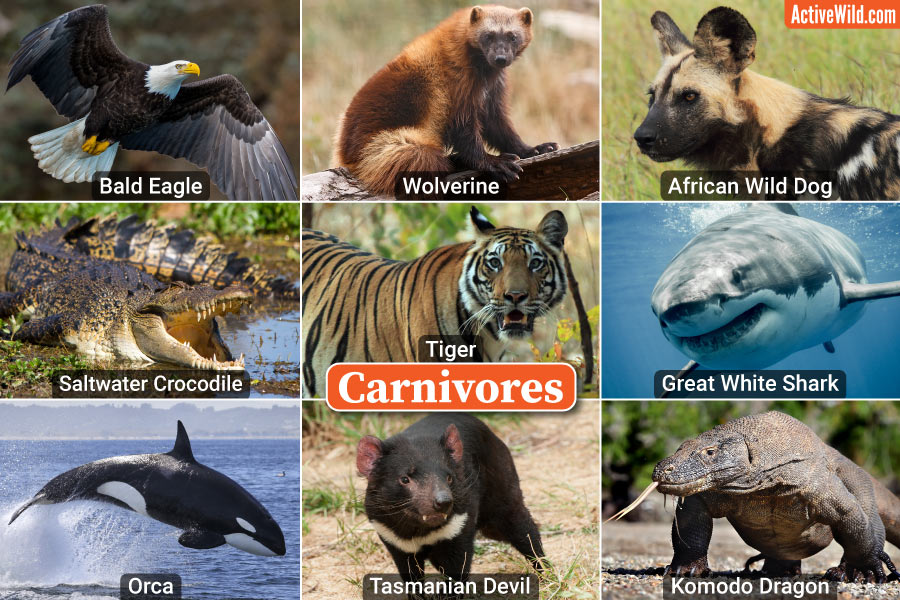Examples of carnivores include land mammals such as the tiger, lion, wolf, wolverine and African wild dog; marine mammals such as seals and the orca; birds such as eagles, owls and shrikes; reptiles such as snakes and crocodiles; and ocean animals such as sharks and squid.
This page contains examples of carnivores, including these and many more carnivorous species...
- You can see a list of omnivorous animals on this page: Examples of Omnivores
- You can see a list of herbivorous animals on this page: Examples of Herbivores
- Discover more about animal diets: What Do Animals Eat?
Use the index below to find information on a particular animal, or continue scrolling to browse all of the animals on the list and to find out more about carnivores.
Carnivores Examples
- African Wild Dog
- American Bullfrog
- Axolotl
- Crocodiles
- Eagles
- Hellbender
- Komodo Dragon
- Lion
- Mongooses
- Octopuses
- Orca
- Owls
- Polar Bear
- Scorpions
- Sea Stars / Starfish
- Seals
- Sharks
- Shrikes
- Spiders
- Squid
- Tasmanian Devil
- Tiger
- Snakes
- Wolf
- Wolverine
What Is A Carnivore?

A carnivore is a meat-eater – a species that obtains the nutrition it needs from animals, rather than plant matter.
Types Of Carnivores
Many carnivores are predators. Predators hunt their own prey and have adaptations such as sharp teeth and claws, forward facing eyes and binocular vision, strength, speed and stealth for hunting and despatching their prey.
Some carnivores are scavengers, feeding on carrion, including the remains of other carnivores’ kills. Scavengers have adaptations such as acute senses for locating food; powerful claws, teeth or bills for breaking food apart; and a strong digestive system for breaking down bones.
A carnivore with no natural predators of its own is known as an apex predator, or top predator.
Examples of apex predators include the tiger, lion, orca and great white shark. Other carnivores, such as the smaller wild cats, most seals and many small sharks, despite being carnivores, may still be prey for other animals.
- You can see more examples of apex predators on this page: Apex Predators List with Pictures & Interesting Facts
An obligate carnivore is an animal that can only get the nutrition it requires from meat; a facultative carnivore is one that is not entirely dependant upon meat for its nutritional requirements.
Some carnivores have specialist diets, for example, insectivores eat insects; and piscivores eat fish. You can see more examples of specialist animal diets on this page: What Do Animals Eat?
Carnivore Vs Carnivoran
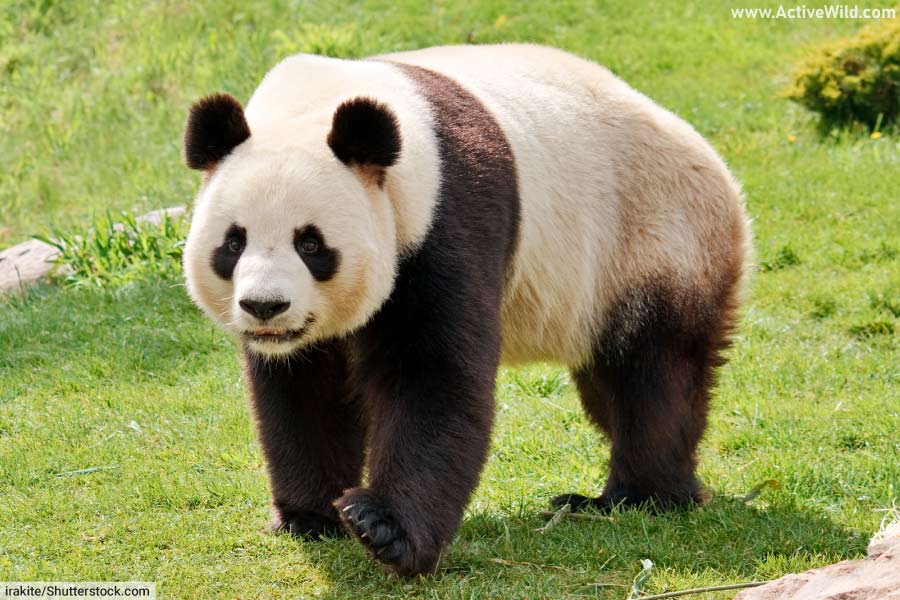
A carnivore is any meat-eater; a carnivoran is a member of a particular group of animals: the mammalian order Carnivora.
Carnivora is a group of mammals that includes families such as Felidae (the cat family), Canidae (the dog family) and Ursidae (the bear family). Pinnipeds (seals, sea lions and the walrus) are a branch of carnivorans adapted to life in the sea.
All carnivorans (including pinnipeds) share a common, carnivorous ancestor. While most living carnivorans are carnivores (e.g. all cats and pinnipeds), some carnivorans are omnivorous (i.e. most bears and badgers). The giant panda, despite being a carnivoran, is almost entirely herbivorous.
Carnivorous Animals List
African Wild Dog
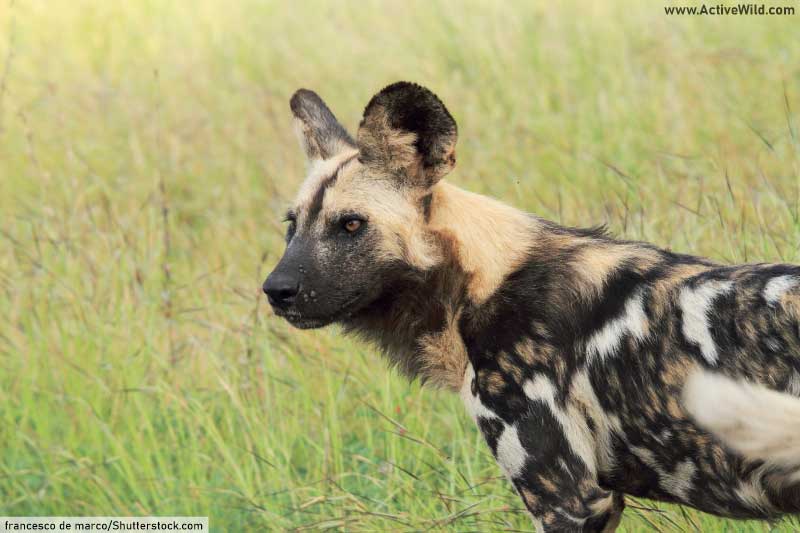
- Scientific name: Lycaon pictus
- Type of animal: Mammal
- Family: Canidae (the dog family)
- Where found: Africa
- Conservation status: Endangered
The African wild dog, which is also known as both the African hunting dog and the African painted dog, is a member of the dog family found in sub-Saharan Africa.
This large and distinctively-colored wild dog lives in scattered colonies throughout sub-Saharan Africa. The species is rare and seldom seen. An endangered species, its habitat has become highly fragmented due to human activity.
The African wild dog lives in packs that consist of 7 to 15 individuals on average, although packs containing up to 40 African wild dogs have been recorded. Unusually among animals that live in groups, it is the males that stay with the pack and the females that disperse to join other packs.
The pack hunts using teamwork, pursuing its prey–typically medium-sized antelopes–until the victim tires and can be overcome.
Antelope species hunted by the African wild dog include the impala, Thompson’s gazelle, greater kudu and blue wildebeest.
Despite the African wild dog’s prey typically being at least twice its size, the dog is a highly-efficient hunter, with a success rate higher than that of both lions and hyenas.
Discover More with Active Wild
- You can read more about African wild dogs on this page: African Wild Dog Facts
- Find out about endangered animals here: Endangered Animals
American Bullfrog
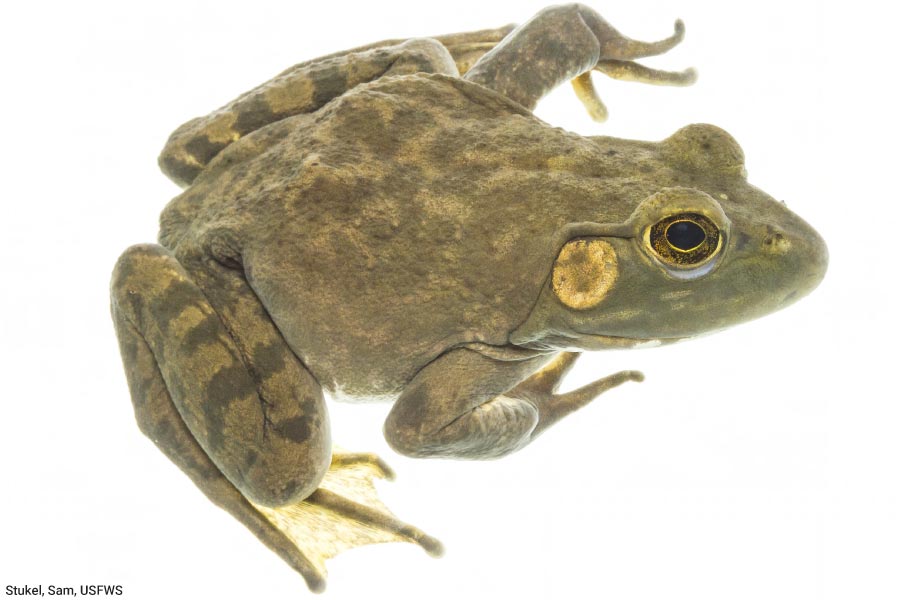
- Scientific name: Lithobates catesbeianus
- Type of animal: Amphibian
- Family: Ranidae
- Conservation status: Least Concern
The American bullfrog is a large frog found in lakes, ponds and other wetland habitats throughout much of North America. During the mating season, male bull frogs make a bull-like bellow, from which the species gets its name.
Like most frogs, the American bullfrog is carnivorous. The amphibian preys on a wide variety of invertebrates and vertebrates, and is not a fussy eater, devouring any animal it can fit in its mouth.
Discover More with Active Wild
- You can find out more about the American bullfrog on this page: American Bullfrog Facts
- Discover more North American amphibians on this page: North American Amphibians List with Pictures & Facts
Axolotl

- Scientific Name: Ambystoma mexicanum
- Type of Animal: Amphibian
- Family: Ambystomatidae
- Where Found: North America
- Conservation Status: Critically Endangered
The axolotl is a critically endangered salamander found in only a small number of canals and lakes in Mexico City.
The axolotl is of great interest to scientists due to its ability to regenerate not only lost limbs, but also parts of the eye, heart and brain. The species is also kept as a pet.
The axolotl differs from many amphibians in that it does not undergo metamorphosis. Even as an adult, the axolotl remains fully-aquatic, breathing with gills rather than with lungs.
Salamanders are members of the amphibian order Urodela. Like all salamanders, the axolotl is a carnivore. It eats a wide variety of invertebrates and small fish, locating its prey by smell and sucking the food into its mouth with a sudden gulping motion.
Discover More with Active Wild
- You can find out more about the axolotl on this page: Axolotl Facts
- Discover more critically endangered species on this page: Critically Endangered Species List with Pictures & Facts
Crocodiles
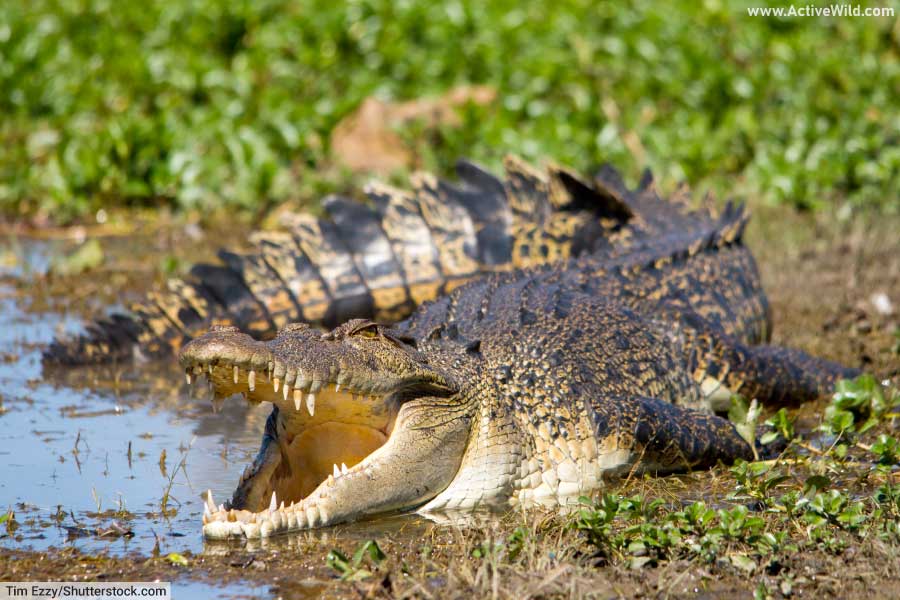
- Type of animal: Reptile
- Family: Crocodylidae
- Where found: Africa, North America, South America, Asia, Australia
Crocodiles are large, semi-aquatic reptiles belonging to the family Crocodylidae. Their closest relatives are alligators, caimans and gharials; all belong to the reptilian order Crocodilia and together are known as “crocodilians”.
All 18 living crocodile species, together with the other crocodilians, are carnivorous.
Crocodiles typically hunt by allowing their prey to draw near before launching themselves forwards, gripping their prey in their incredibly powerful jaws and pulling it backwards into the water. Crocodiles swallow stones, which may help the digestive process.
Surprisingly, some crocodiles have been recorded eating fruit.
The largest crocodile species is the saltwater crocodile, which can reach lengths in excess of 6 m / 20 ft; the smallest is the 1.5 m / 5 ft. African dwarf crocodile.
Discover More with Active Wild
- You can find out more about reptiles on this page: Reptiles – The Ultimate Guide
- Discover different types of reptiles on this page: Types of Reptiles
Eagle
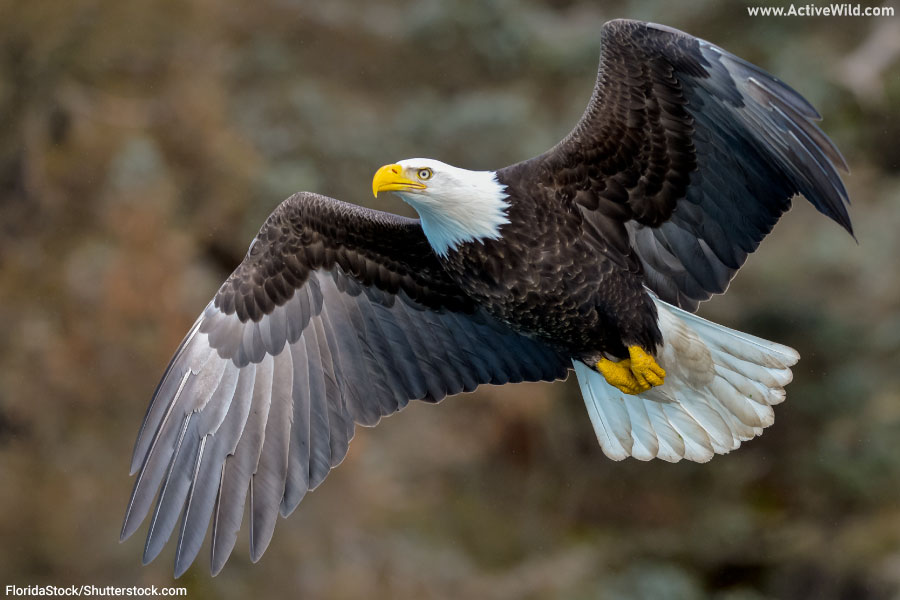
- Type of animal: Bird
- Family: Accipitridae
- Where found: All continents except Antarctica
Eagles are large birds of prey belonging to the family Accipitridae, which is also home to other predatory birds such as hawks, kites, harriers and Old World vultures.
Two of the largest eagle groups are the “true eagles” of genus Aquila, and the “sea eagles” of genus Haliaeetus.
Examples of true eagles include the golden eagle and the wedge-tailed eagle; examples of sea eagles include the bald eagle and the white-tailed eagle.
Characteristics of eagles include large size, large hooked bill, powerful talons, excellent vision and the ability to fly (and dive) at high speed. These adaptations help to make eagles fearsome predators, capable of taking prey several times larger than themselves.
An eagle's nest is known as an eyrie.
Discover More with Active Wild
- You can find out more about birds on this page: Birds – The Ultimate Guide
- Discover different types of birds on this page: Types of Birds
Hellbender
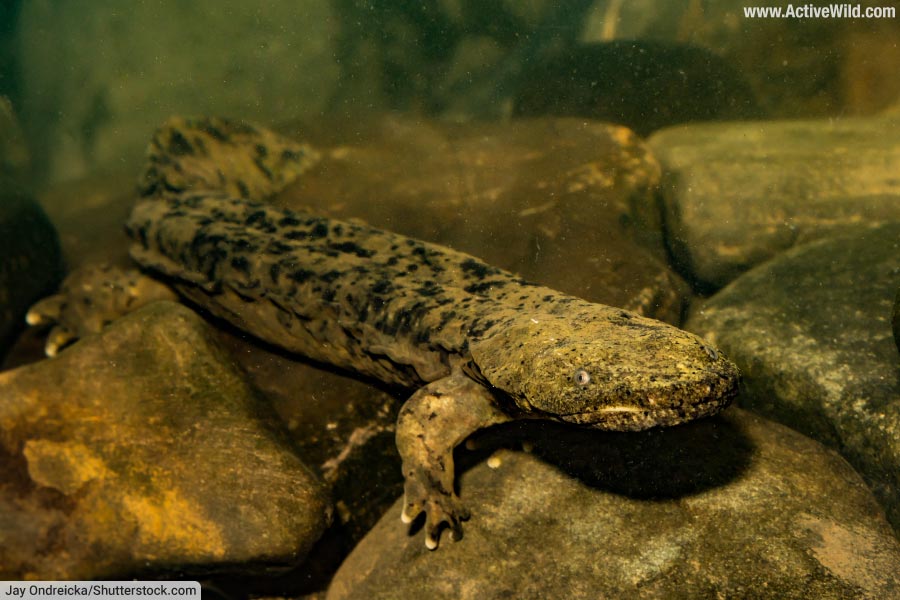
- Scientific Name: Cryptobranchus alleganiensis
- Type of Animal: Amphibian
- Family: Cryptobranchidae
- Where Found: North America
- Conservation Status: Vulnerable
The hellbender is an amphibian that lives in fast-flowing rivers and streams in the eastern United States.
Despite being the smallest member of the giant salamander family, Cryptobranchidae, the hellbender is the largest amphibian found in North America, reaching a length of up to 74 cm / 29 in. (The other giant salamanders are found in Asia.)
Unlike many amphibians, which can live away from water after undergoing metamorphosis, the hellbender remains fully aquatic even in adulthood.
The folds of skin that run along the sides of the hellbender’s body are able to absorb oxygen from the water. Most of the oxygen required by the amphibian is obtained via the wrinkled frills of skin running along the sides of its body.
Like all salamanders (and most amphibians), the hellbender is a carnivore. It preys mainly on crayfish, but will take numerous other types of both invertebrate and vertebrate prey, including other salamanders.
Discover More with Active Wild
- You can find out more about the hellbender on this page: Hellbender Facts
- Find out more about amphibians on this page: Amphibians – The Ultimate Guide
Komodo Dragon
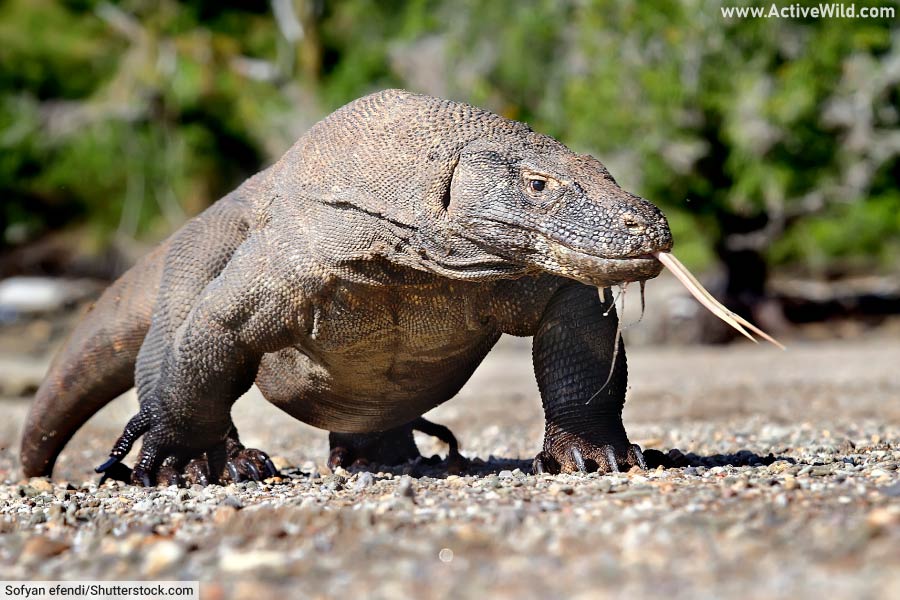
- Scientific name: Varanus komodoensis
- Type of animal: Reptile
- Family: Varanidae
- Where found: Asia
- Conservation status: Endangered
The Komodo dragon is the world’s largest lizard, reaching lengths of over 3 m / 9.8 feet and weights of around 165 kg / 364 lbs. This fearsome meat-eater is found not just on the Indonesian island of Komodo (from which it gets its name), but also two other, neighboring, islands.
A carnivore, the Komodo dragon feeds mainly on carrion, but will also hunt its own prey, including animals much larger than itself. Prey targeted by the lizard ranges from birds to large animals such as wild pigs and water buffalo.
When hunting, the Komodo dragon uses an ambush strategy, waiting for an animal to come close before pouncing, then following the prey until it succumbs either from blood loss due to the lizard’s anti-clotting venom, or infection caused by bacteria in the Komodo dragon’s saliva.
Discover More with Active Wild
- You can find out more about the Komodo Dragon on this page: Komodo Dragon Facts
- Discover different types of lizards on this page: Types of Lizards
Lion
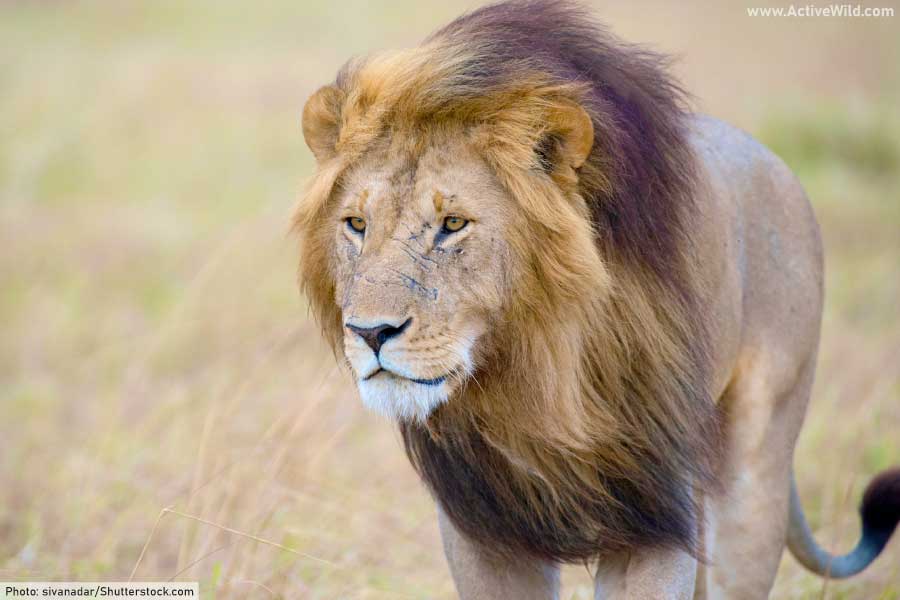
- Scientific name: Panthera leo
- Type of animal: Mammal
- Family: Felidae
- Where found: Africa, Asia
- Conservation status: Vulnerable
The lion is the second-largest member of the cat family; only the tiger is larger. The only big cat that is not solitary, the lion lives in groups called “prides”.
Due to the amount of energy that is spent hunting and digesting large prey, a lion may spend 20 to 21 hours a day sleeping.
The lion, like all cats, is an obligate carnivore – it can only get the nutrients it needs from flesh.
The lion’s preferred prey items are medium sized ungulates (hoofed animals), but it will also eat carrion and steal food caught by other carnivores, such as hyenas and leopards.
Most of the world’s lions live in Africa, but there is a small population of around 650 lions that live in a small area in India’s Gir Forest. These Asiatic lions are slightly smaller than their African cousins.
Discover More with Active Wild
- You can find out more about lions on this page: Lion Facts
- You can see EVERY species of cat on this page: Wild Cats Species List with Pictures and Facts
- You can see more African animals on this page: African Animals
Mongoose
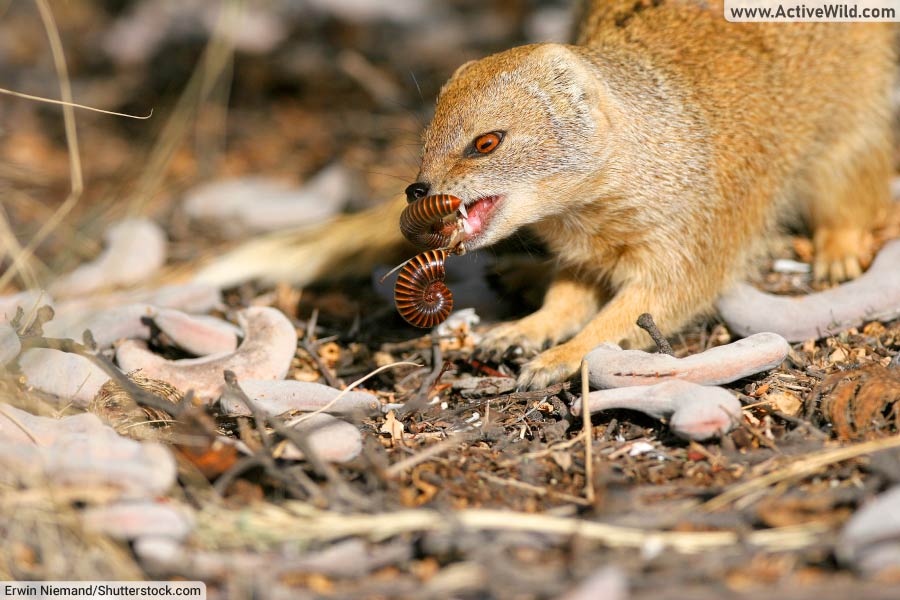
- Type of animal: Mammal
- Family: Herpestidae
- Where found: Europe, Africa, Asia
Mongooses are small carnivorans (members of the order Carnivora) with long bodies, long tails and short legs. The 29 species of mongoose make up the family Herpestidae.
Mongooses are found in Africa and Eurasia. They are resistant to the venom produced by some snakes.
Mongooses are primarily carnivorous, preying on a variety of animals, including small mammals, reptiles and insects.
Discover More with Active Wild
- You can find out more about mammals on this page: Mammals – The Ultimate Guide
- Discover different types of mammals on this page: Types of Mammals
Octopus
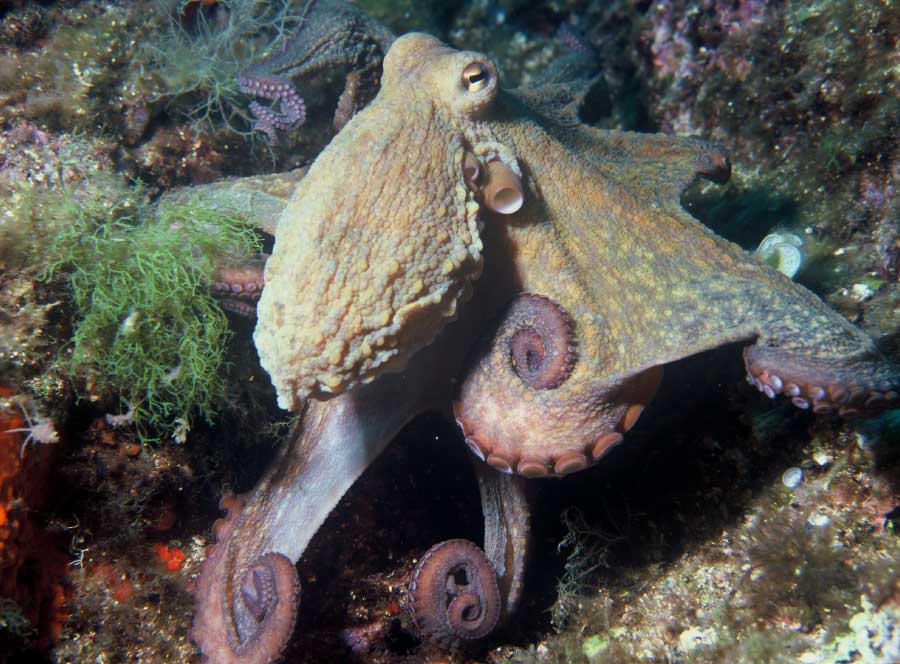
- Type of animal: Mollusk
- Order: Octopoda
- Where found: Oceans Worldwide
Octopuses are soft-bodied marine mollusks with eight legs. The 310 species of octopus (source) make up the order Octopoda, which is part of a larger group of mollusks, the class Cephalopoda. Other cephalopods include squid, cuttlefish and nautiloids.
Octopuses prey on a variety of animals, but the most important prey for many species are bivalves – mollusks with two-part shells, and crustaceans such as crabs and crayfish.
Octopuses either prize open the shells of their shellfish prey, or create small holes in the shells through which they inject venom.
Octopuses are highly intelligent, with a brain-to-body size ratio higher than any other invertebrate. Species such as the common octopus are able to solve puzzles, and in the wild are known to steal prey from lobster pots.
Discover More with Active Wild
- Discover different types of mollusks on this page: Mollusks Examples
- You can see more ocean animals on this page: Ocean Animals List with Pictures & Facts
Orca
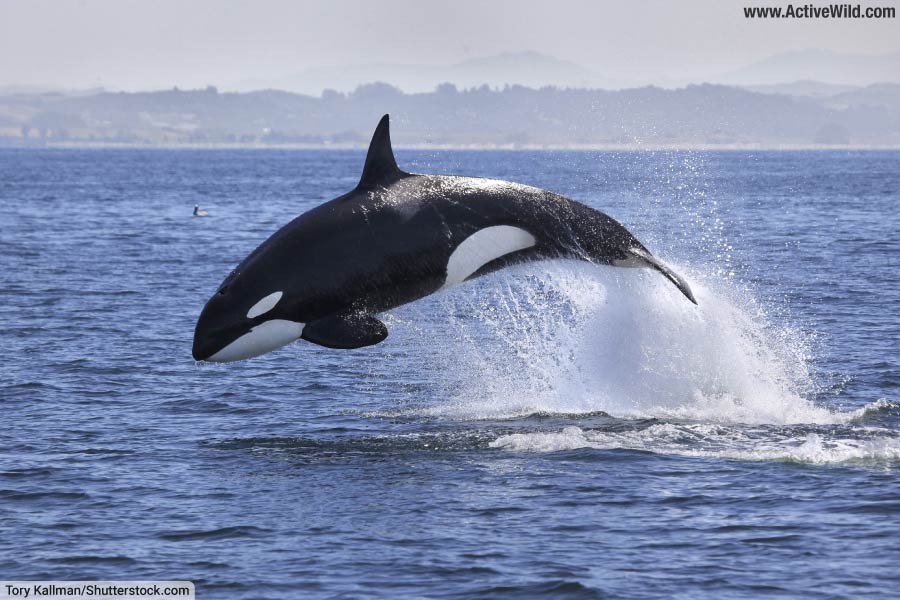
- Scientific name: Orcinus orca
- Type of animal: Mammal
- Family: Delphinidae
- Where found: Oceans worldwide
- Conservation status: Data Deficient
The orca, or killer whale, is the largest member of the oceanic dolphin family, Delphinidae. Due to its large size and black and white markings, the orca is one of the most recognizable cetaceans. (The cetaceans are a group of fully-aquatic marine mammals that includes whales, dolphins and porpoises.)
The killer whale is the most widely-distributed cetacean, and is found in all of the world’s oceans.
Like all dolphins, the orca belongs to a group of cetaceans known as “toothed whales”. All toothed whales are carnivores.
The orca, due to its size, power, and intelligence, is an apex predator. It hunts a wide variety of animals, including fish and marine mammals such as seals and whales.
Pods of killer whales often use teamwork to capture and overcome their prey.
The orca has good eyesight but relies mostly on echolocation when hunting. It is an efficient predator with a high success rate, eating around 136 kg / 300 lbs. of food per day.
Discover More with Active Wild
- You can find out more about orcas on this page: Orca Facts
- You can see more ocean animals on this page: Ocean Animals List with Pictures & Facts
- Discover more about whales on this page: Are Whales Mammals?
- You can see more apex predators on this page: Apex Predators List
Owls
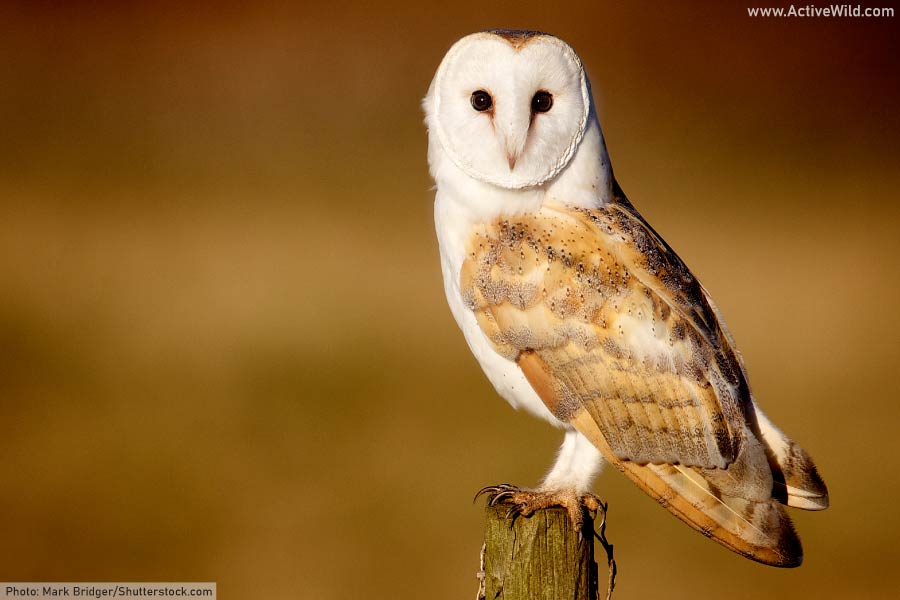
- Type of animal: Bird
- Order: Strigiformes
- Where found: All continents except Antarctica
Owls are predatory birds in the order Strigiformes. They are highly-distinctive birds, with most owls having rounded faces, large eyes, and an upright stance. Most owls are nocturnal.
239 living owl species are currently recognized. (source)
An owl’s large eyes provide excellent night-time vision, but many owls locate prey by sound, rather than by sight.
An owl’s ears are positioned asymmetrically, meaning that sound reaches each ear at slightly different times. This enables owls to accurately judge from which direction a sound is coming.
Owls typically hunt small rodents, but depending on size and species also target insects, larger mammals, birds and fish.
Discover More with Active Wild
- You can find out more about birds on this page: Birds – The Ultimate Guide
- Discover different types of birds on this page: Types of Birds
- You can see more owls on this page: Types Of Owls
- You can see more nocturnal animals on this page: Nocturnal Animals List with Pictures & Facts
Polar Bear

- Scientific name: Ursus maritimus
- Type of animal: Mammal
- Family: Ursidae
- Where found: North America, Europe, Asia
- Conservation status: Vulnerable
Whereas most bears are omnivorous, the polar bear’s diet consists mainly of meat.
The distinctive white bear is the largest of the eight living bear species, and a top predator in the Arctic region in which it is found.
Seals, in particular the ringed seal, form the bulk of the polar bear’s diet. Other seal species commonly targeted by the bear include the bearded, harp, harbor and hooded seal.
The polar bear will often lie in wait for several hours by a seal breathing hole, using its excellent sense of smell to detect both the location of a hole, and the breath of a seal when it emerges from the water.
The polar bear also stalks prey, using stealth to slowly approach a resting seal before pouncing.
The remains of a polar bear kill are an important source of food for other Arctic meat-eaters, including the Arctic fox.
Discover More with Active Wild
- You can find out more about polar bears on this page: Polar Bear Facts
- You can find out more about bears on this page: Bears – The Ultimate Guide
- Discover all eight types of bear on this page: Types of Bears
- You can see more Arctic animals on this page: Arctic Animals
Scorpions
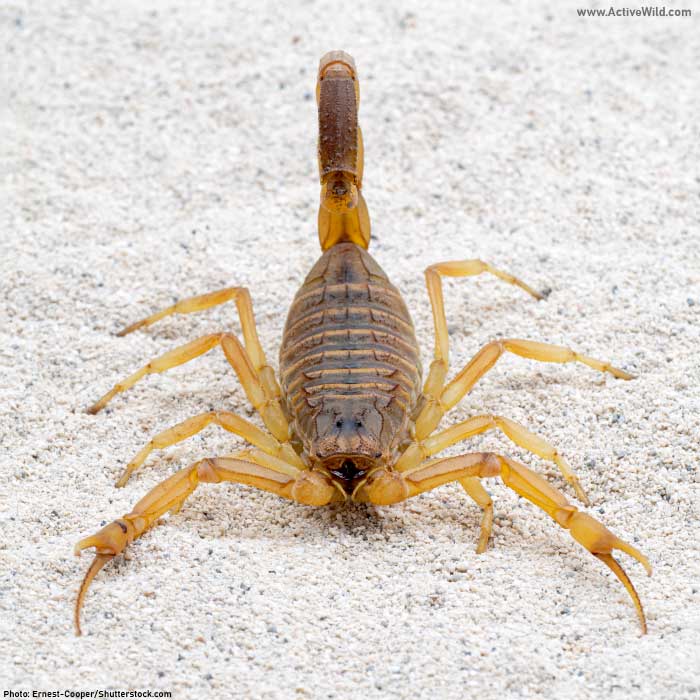
- Subphylum: Chelicerata
- Order: Scorpiones
Scorpions are arachnids in the order Scorpiones. Scorpions have eight legs, and can be differentiated from other arachnids by their pedipalps, which take the form of large pincers, and by their extended tails, which are equipped with a venomous stinger.
Insects form the bulk of the diet of most scorpions. Small reptiles and mammals may also be taken. Scorpions can sense the vibrations produced by potential prey with highly-sensitive hairs on their bodies. Scorpions generally only sting larger prey animals, their pincers being sufficient to overcome smaller species.
Out of the 2,684 currently recognized scorpion species (source), only a very small percentage are capable of inflicting a sting lethal to a healthy adult human. Even a sting from a deathstalker scorpion – one of the most dangerous scorpion species – is rarely fatal, especially if medical treatment is available.
Discover More with Active Wild
- You can find out more about scorpions on this page: Scorpion Facts
- You can find out more about arachnids on this page: Arachnids – The Ultimate Guide
- You can find out more about the deathstalker scorpion on this page: Deathstalker Scorpion Facts
Sea Stars / Starfish

- Type of animal: Echinoderm
- Class: Asteroidea
- Where found: Oceans worldwide
Sea stars, also known as starfish, are a group of marine invertebrates that make up the class Asteroidea. (Despite being known as “starfish”, sea stars are not fish!)
Most sea stars have five arms. At the end of each arm is a group of light-sensitive “eye” cells. Sea stars hunt by touch and smell. They prey on animals such as sponges and small mollusks.
Some sea stars have specialized diets; the crown-of-thorns starfish is notorious for targeting corals. Outbreaks of this large starfish can decimate coral reefs.
Discover More with Active Wild
- Discover more about the world’s oceans on this page: The Marine Biome
- You can see more ocean animals on this page: Ocean Animals List with Pictures & Facts
Seals
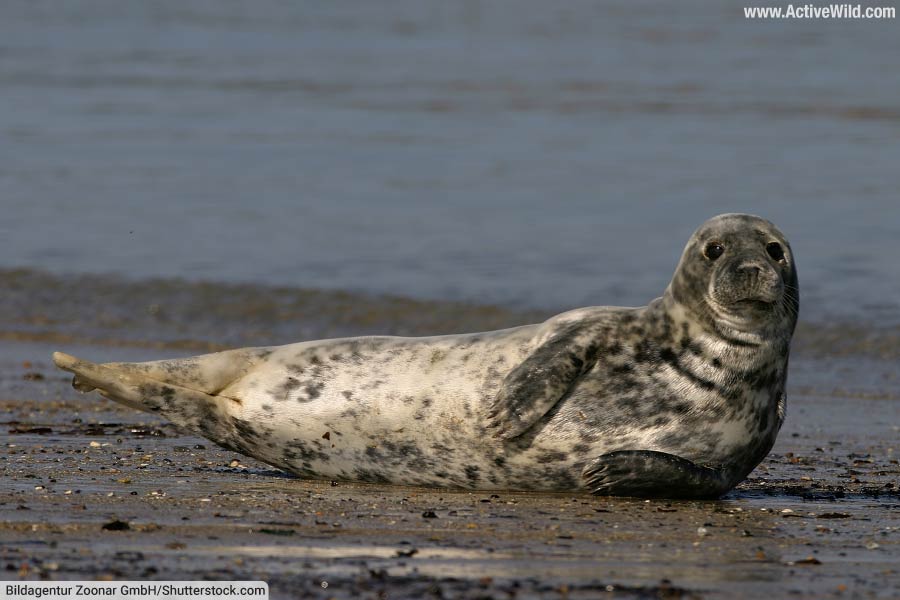
- Type of animal: Mammal
- Clade: Pinnipedia
- Where found: Mostly temperate and polar waters
Seals, together with sea lions and the walrus, make up group of marine mammals known as Pinnipeds. All pinnipeds are carnivorous.
Otariidae, the “eared seal” family, is home to sea lions and fur seals; Phocidae, the “earless seal” family, is home to the “true seals”. The walrus is the only member of the third pinniped family, Odobenidae.
Examples of eared seals include the California sea lion (Zalophus californius), and the northern fur seal (Callorhinus ursinus).
Examples of earless seals include the ringed seal, (Pusa hispida), and the southern elephant seal, (Mirounga leonina), which is both the world's largest seal, and the world's largest carnivoran. (Note: carnivorans are not the same as carnivores – see the note at the top of the page.)
The “true seals” are more streamlined, and capable of swimming more efficiently, than their eared cousins. However, they are very clumsy on land, being unable to walk with their hind flippers.
Eared seals are extremely fast and maneuverable in the water, and better able to move around on land (although still clumsy), being able to use both their fore and hind flippers to move.
Seals eat a wide variety of sea animals, with fish, cephalopods and crustaceans being the marine mammals’ main prey.
Discover More with Active Wild
- You can find out more about mammals on this page: Mammals – The Ultimate Guide
- Discover different types of mammals on this page: Types of Mammals
- Discover the seals that live in the Arctic: Arctic Seals
- Discover the seals found in Antarctica: Antarctic Seals
Sharks

- Type of animal: Fish
- Class: Chondrichthyes
- Where found: Oceans Worldwide
Nearly all of the 500-plus shark species are carnivores.
Sharks are some of the best-known predators of the oceans (only a handful of shark species, including the river sharks, are found in freshwater habitats).
Species such as the great white shark, tiger shark and bull shark are known to attack humans (although such attacks are rare).
Sharks are fast, silent and powerful predators. Their mouths are lined with multiple rows of teeth, which are continually replaced through the fish’s lifetime, with new teeth being pushed forwards on a “conveyor belt” system.
Sharks have a “sixth sense” in the form of hundreds of electroreceptive organs called ampullae of Lorenzini embedded in their skin. Using these, a shark can sense the electrical fields produced by the muscles of potential prey.
Whereas the skeletons of most fish are made of bone, those of sharks are made of cartilage, a tough, yet flexible natural substance. Sharks, along with rays and skates, belong to a group of fish known as “cartilaginous fish” on behalf of their cartilage skeletons.
Discover More with Active Wild
- Find out more about sharks on this page: Shark Facts
- Discover different types of sharks on this page: Types of Sharks
- You can find out more about fish on this page: Fish - The Ultimate Guide
Shrikes
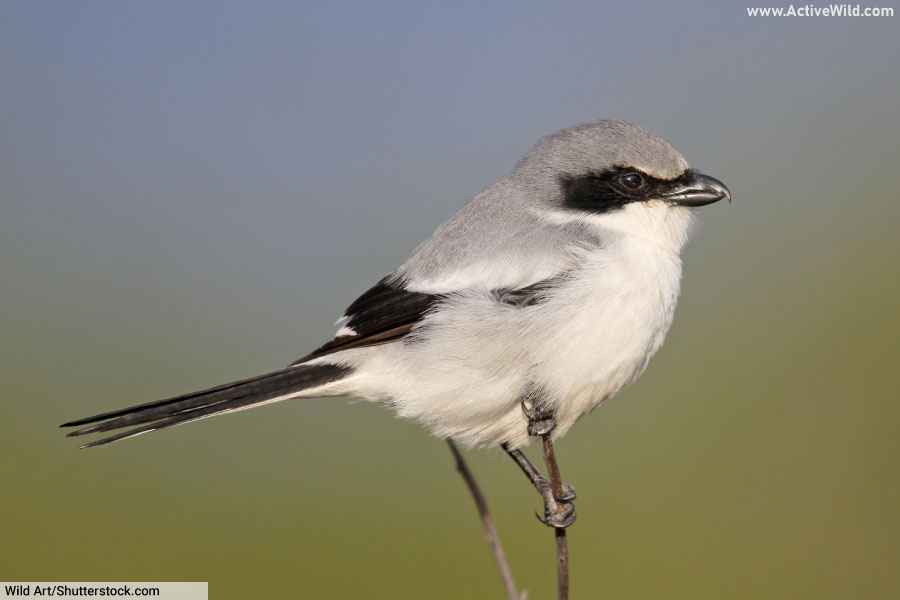
- Type of animal: Bird
- Family: Laniidae
- Where found: Europe, Asia, North America, Africa
The order Passeriformes is a large group of birds which includes groups such as crows, wrens, thrushes and finches. Passerines are also known as “perching birds” or “song birds”.
Whereas most passerines are omnivores, shrikes, which make up the family Laniidae, are carnivores.
Shrikes are typically thrush-sized birds with powerful, hooked bills that reflect their carnivorous lifestyle.
Shrikes feed on insects and small vertebrates. The carnivorous birds often impale their prey on thorns (or barbed wire) for later consumption. Due to this habit, shrikes are often known as “butcherbirds”.
Discover More with Active Wild
- You can find out more about birds on this page: Birds – The Ultimate Guide
- Discover different types of birds on this page: Types of Birds
Snakes
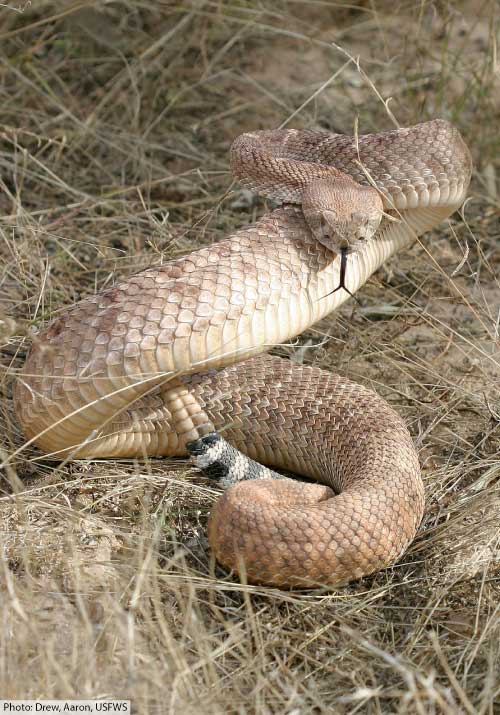
- Type of animal: Reptile
- Order: Squamata
- Where found: All continents except Antarctica
Snakes are reptiles that belong, along with lizards, in the order Squamata. Although snakes lack limbs, their ancestors were limbed lizards. Unlike (most) lizards, snakes lack eyelids and therefore cannot blink.
There are just over 4,000 living snake species. (source)
All snakes are carnivorous. Most are generalist carnivores, preying on a variety of animals, while others are more specialized; the king cobra preys mainly on other snakes.
Snakes have numerous adaptations for hunting, including a flexible lower jaw that allows prey items to be swallowed whole (snakes can’t break their food up into smaller pieces) and the ability to locate prey by “tasting” the air with their sensitive forked tongues.
Many snakes are venomous, while some snakes overcome their prey by constriction, wrapping their bodies around their prey and gradually tightening their grasp.
Discover More with Active Wild
- You can find out more about snakes on this page: Snake Facts
- Discover different types of snakes on this page: Types of Snakes
Spiders
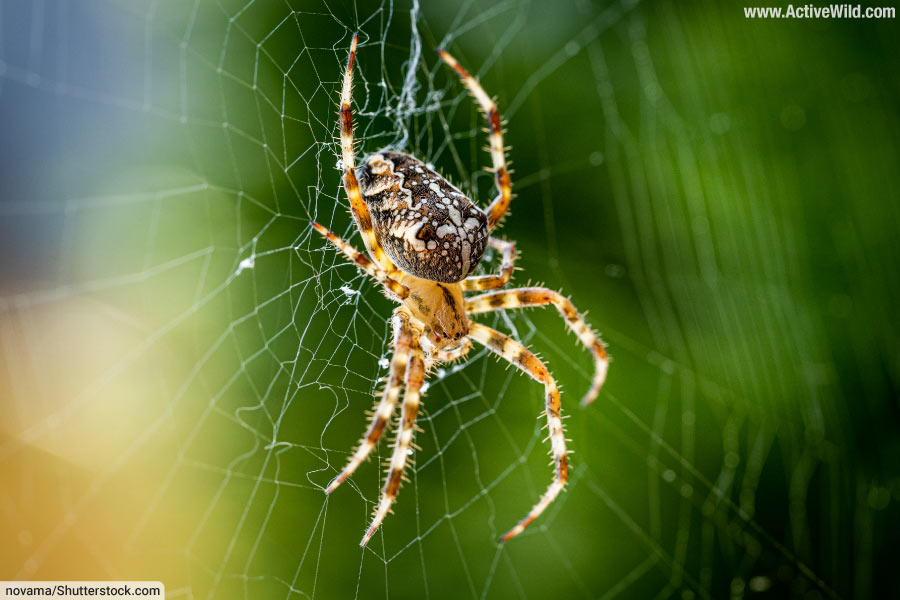
Spiders are arachnids with eight legs, two-part bodies, silk-producing spinnerets on the abdomen, and hollow fangs known as “chelicerae” with which the spider injects venom into its prey.
There are 50,783 spider species currently listed in the World Spider Catalog, a database of spider species. (source)
Nearly all spiders are carnivores; only a handful of species are known to eat a significant amount of plant material.
Spiders employ a wide range of hunting strategies. Orb-weaver spiders such as North America’s yellow garden spider and the European garden spider spin intricate flat webs to capture insect prey. Large species such as South America’s Goliath birdeater and Asia’s giant huntsman actively hunt their prey. Australian funnel web spiders such as the Sydney funnel-web spider build burrows from which they ambush their prey.
Although the vast majority of world’s spiders are harmless to humans, a number of species are able to inflict painful, and in some cases, life-threatening, bites.
Discover More with Active Wild
- You can find out more about arachnids on this page: Arachnids – The Ultimate Guide
Squid
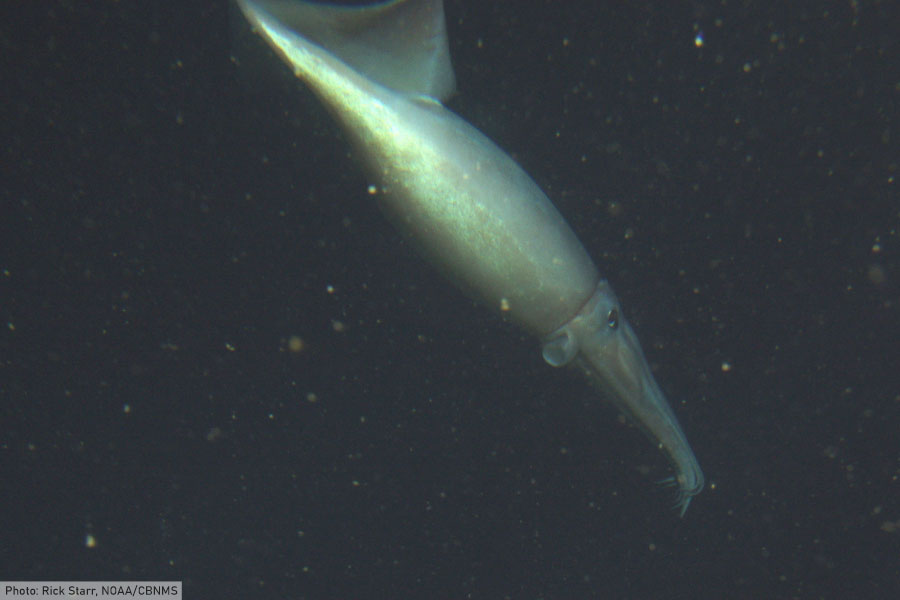
- Type of animal: Mollusk
- Class: Cephalopoda
Squid are cephalopod mollusks which, like cuttlefish, have eight legs and two tentacles. Unlike cuttlefish, squid lack a cuttlebone. Instead, their bodies contain a hard, feather-shaped shaped structure called a pen.
Squid are predatory animals, hunting their prey by sight and using jet propulsion to travel at high speed through the water. Their prey consists of fish, crustaceans and other cephalopods, including other squid (sometimes of the same species).
Discover More with Active Wild
- Discover different types of mollusks on this page: Mollusks Examples
- You can see more ocean animals on this page: Ocean Animals List with Pictures & Facts
Tasmanian Devil
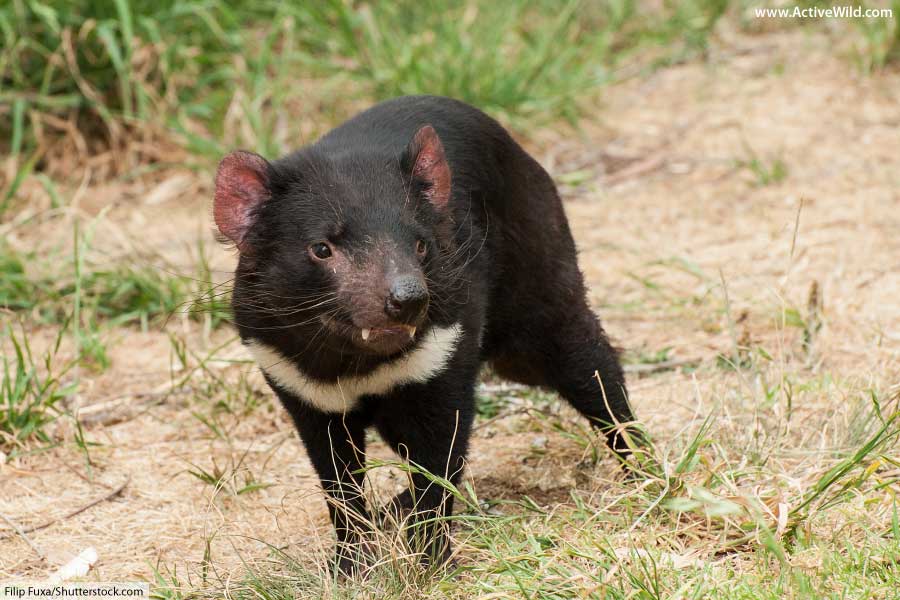
- Scientific name: Sarcophilus harrisii
- Type of animal: Mammal
- Where found: Australia
- Conservation status: Endangered
The Tasmanian devil is the world’s largest carnivorous marsupial. It is a member of the family Dasyuridae, which is also home to quolls and other mainly carnivorous / insectivorous marsupials.
Most wild Tasmanian devils are found on the Australian island state of Tasmania. A small number have been reintroduced onto the Australian mainland.
The Tasmanian devil gets its name for its terrifying night-time screeches and aggressive feeding behavior.
The Tasmanian devil is endangered due to the spread of Devil Facial Tumor Disease (DFTD), which has caused a large decline in the species’ population.
Discover More with Active Wild
- You can find out more about the Tasmanian devil on this page: Tasmanian Devil Facts
- You can see more Australian animals on this page: Australian Animals
- You can see more endangered animals on this page: Endangered Animals List
Tiger

- Scientific Name: Panthera tigris
- Type Of Animal: Mammal
- Family: Felidae
- Where Found: Asia
- Conservation Status: Endangered
The tiger is the world’s largest species of cat. With its distinctive orange coat and black stripes, it is also one of the world’s most recognizable animals.
Despite being found over a range stretching from Siberia to India, the tiger is extremely rare. There are thought to be fewer than 4,000 tigers left in the wild. Sadly, the main threat to the tiger is illegal poaching.
The tiger is an apex predator wherever it is found. This powerful carnivore is capable of bringing down prey as large as a buffalo or gaur (Indian bison).
Discover More with Active Wild
- You can find out more about tigers on this page: Tiger Facts
- Discover more apex predators: Apex Predators List with Pictures & Facts
- You can see EVERY species of cat on this page: Wild Cats Species List with Pictures and Facts
Wolf
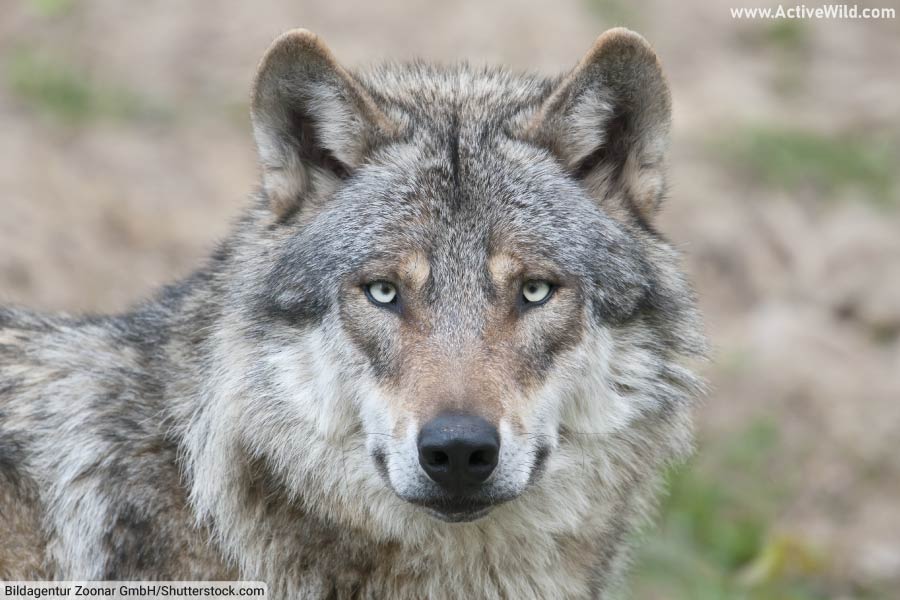
- Scientific Name: Canis lupus
- Type of Animal: Mammal
- Family: Canidae
- Conservation Status: Least Concern
The wolf, or gray wolf to give the species its full name, is the largest member of the dog family, Canidae (although some domestic dog breeds are larger).
Thirty-seven subspecies (“types”) of wolf are currently listed in the Mammal Species of the World database. (source)
A highly social animal, the wolf lives in a family group known as a “pack”. All members of the pack protect and care for the pups.
A carnivore, the wolf hunts both alone and in packs. It can run at speeds of 61.2 km / 38 miles an hour in short bursts while chasing prey. It is opportunistic and will feed on carrion when given the chance.
Discover More with Active Wild
- You can find out more about wolves on this page: Wolf Facts
- See every wild dog species on this page: Wild Dogs – Pictures & Facts On Every Species
Wolverine
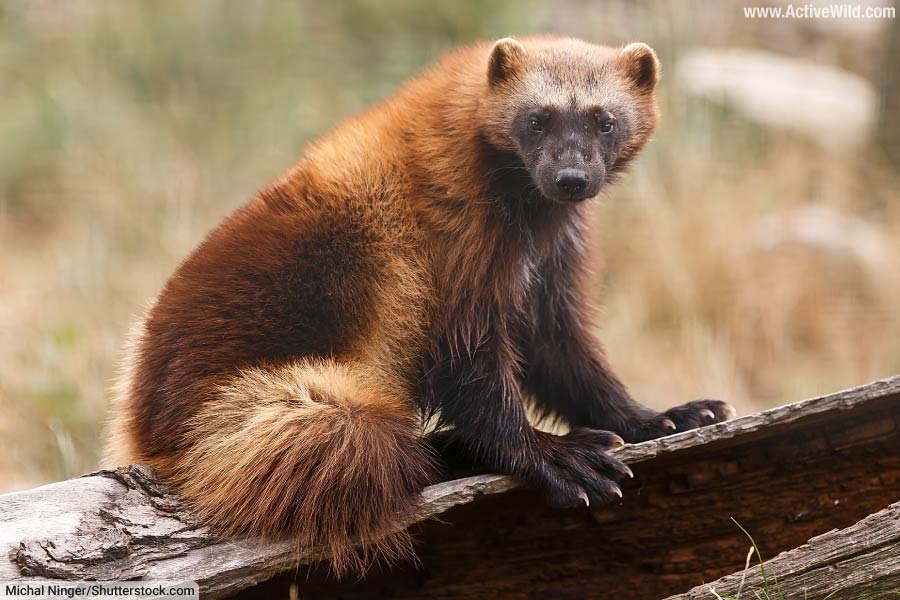
- Scientific name: Canis lupus
- Type of animal: Mammal
- Family: Mustelidae
- Where found: North America, Europe, Asia
- Conservation status: Vulnerable
The wolverine is one of the largest members of the weasel family, Mustelidae, which is also home to animals such as badgers and otters.
Found in cold northern boreal forests of the Northern Hemisphere, the wolverine competes with larger predators such as wolves, bears, and the mountain lion.
Primarily a scavenger, the wolverine often feeds on the remains of prey captured by larger carnivores. The species is also a capable hunter, feeding mainly on rodents, but also tackling larger prey such as deer on occasion.
Discover More with Active Wild
- You can find out more about the wolverine on this page: Wolverine Facts
- You can see more boreal forest / taiga animals on this page: Taiga Animals
- You can see more Arctic animals on this page: Arctic Animals
Discover More With Active Wild
- You can find a complete guide to the animal kingdom on this page: Animals
- Find out more about animal habitats on this page: Animal Habitats
- Find out where animals on every continent: Animals Around The World
- You can see a list of omnivorous animals on this page: Examples of Omnivores
- You can see a list of herbivorous animals on this page: Examples of Herbivores
- You can see a list of apex predators on this page: Examples of Apex Predators

